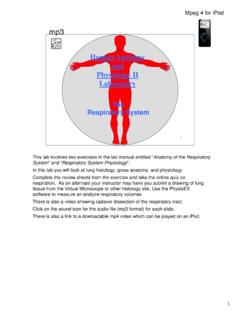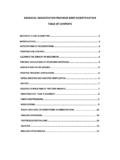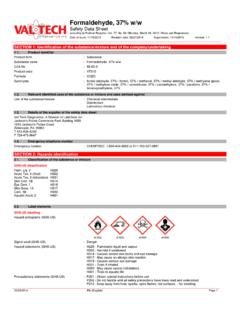Transcription of ADENOIDS - ENT Lectures
1 ADENOIDS Disclaimer: The pictures used in this presentation have been obtained from a number of sources. Their use is purely for academic and teaching purposes. The contents of this presentation do not have any intended commercial use. In case the owner of any of the pictures has any objection and seeks their removal please contact at The se pictures will be removed immediately. Embryology The formation of the ADENOIDS begins in the 3rd month of fetal development. This starts with glandular primordia in the posterior nasopharynx becoming associated with infiltrating lymphocytes. In the 5th month sagittal folds are formed which are the beginnings of pharyngeal crypts. The surface is covered with pseudostratified ciliated epithelium. By the 7th month of development the ADENOIDS are fully formed.
2 Anatomy The lymphoid tissue of the nasopharynx and oropharynx is composed of the ADENOIDS , the tubal tonsils, the lateral bands, the palatine tonsils, and the lingual tonsils. There are also lymphoid collections in the posterior pharyngeal wall and in the laryngeal ventricles. These structures form a ring of tissue named Waldeyer s ring after the German anatomist who described them. The ADENOIDS or pharyngeal tonsil It is a single mass of pyramidal tissue with its base on the posterior nasopharyngeal wall and it s apex pointed toward the nasal septum. The surface is invaginated in a series of folds. The epithelium is pseudostratified ciliated epithelium and is infiltrated by the lymphoid follicles. Blood supply is from the: Ascending palatine branch of the facial artery Pharyngeal branch of the internal maxillary artery Artery of the pterygoid canal Ascending cervical branch of the thyrocervical trunk.
3 Venous drainage is through the pharyngeal plexus and the pterygoid plexus flowing ultimately into the facial and internal jugular veins. Innervation is derived from the glossopharyngeal and vagus nerves. Efferent lymphatics drain to the retropharyngeal nodes and the upper deep cervical nodes. Function and Immunology The tonsils and ADENOIDS are part of the secondary immune system. Without afferent lymphatics the lymphoid nodules in these structures are exposed to antigen only in the crypts of the palatine tonsils and the folds of the ADENOIDS where it is transported through the epithelial layer. These are involved in the production of mostly secretory IgA, which is transported to the surface providing local immune protection. Acute adenoiditis symptoms include purulent rhinorrhea, nasal obstruction, fever, and sometimes otitis media.
4 This can be difficult to differentiate from an acute upper respiratory infection but tends to have a longer and more severe course. Acute adenoiditis symptoms include purulent rhinorrhea, nasal obstruction, fever, and sometimes otitis media. This can be difficult to differentiate from an acute upper respiratory infection but tends to have a longer and more severe course. Recurrent acute adenoiditis is 4 or more episodes of acute adenoiditis in a 6-month period with intervening periods of wellness. Chronic adenoiditis symptoms include persistent rhinorrhea, postnasal drip, malodorous breath, and associated otitis media or extra esophageal reflux lasting at least 3 months. Obstructive adenoid hyperplasia includes symptoms of chronic nasal obstruction, rhinorrhea, snoring, mouth breathing, and a hyponasal voice.
5 Obstructive sleep apnea in children is clinically marked by loud snoring, apneic episodes while sleeping, daytime somnolence, behavioral problems, and enuresis adenoid facies or long face syndrome . It is the long, open-mouthed, face of children with adenoid hypertrophy. The mouth is always open because upper airway congestion has made patients obligatory mouth breathers. The most common presenting symptoms are chronic mouth breathing and snoring. The most dangerous symptom is sleep apnea The characteristic facial appearance consists of: Underdeveloped thin nostrils Short upper lip Prominent upper teeth Crowded teeth Narrow upper alveolus High-arched palate Hypoplastic maxilla Eustachian blockage causing glue ear-deafness The deafness and inattentiveness interferes with the learning Child grows with lowered intelligence and understanding Diagnosis Posterior Rhinoscopy Nasopharygoscopy Nasopharygoscopy Nasopharygoscopy X-Ray soft tissue nasopharynx-lateral view X-Ray soft tissue nasopharynx-lateral view CT Scan Adenoidectomy-Indications Four or more episodes of recurrent purulent rhinorrhea in prior 12 months in a child <12.
6 One episode documented by intranasal examination or diagnostic imaging. Persisting symptoms of adenoiditis after 2 courses of antibiotic therapy. Sleep disturbance with nasal airway obstruction persisting for at least 3 months. Hyponasal or nasal speech Adenoidectomy-Indications Otitis media with effusion >3 months or second set of tubes Dental malocclusion or orofacial growth disturbance documented by orthodontist. Cardiopulmonary complications including cor pulmonale, pulmonary hypertension, right ventricular hypertrophy associated with upper airway obstruction. Otitis media with effusion over age 4. Contraindications A submucous cleft palate which may lead to velopharyngeal insufficiency after surgery. If the adenoid obstruction is severe enough, then only superior half adenoidectomy is performed.
7 Avoid surgery in patients with hemoglobin less than 10. Perform surgery at least 2 weeks after the last attack of acute tonsillitis. Wait at least 6 weeks after polio vaccination. Avoid surgery in patients with uncontrolled systemic diseases (ie. leukemia). Jennings's Mouth Gag St. Claire Thomson adenoid Curette Position for Adenoidectomy Adenoidectomy Adenoidectomy Specimen Complications The incidence of mortality from adenotonsillar surgery ranges from 1 in 16,000 to 1 in 35,000 cases. Anesthetic complications and hemorrhage cause the majority of deaths. The prevalence of hemorrhage ranges from to It is divided into primary bleeding, in the first 24 hours, and secondary bleeding, around 7-10 days post operatively. Other risks include: Vomiting Dehydration Airway obstruction due to edema Pulmonary edema Fever, velopharyngeal insufficiency Dental injury Burns Nasopharyngeal stenosis.
8 Atlantoaxial subluxation can occur in patients with Down syndrome. Atlantoaxial joint laxity because of Grisel s syndrome. This is vertebral body decalcification and laxity of the anterior transverse ligament between the atlas and the axis from inflammation or infection in the nasopharynx. Spontaneous subluxation occurs about 1 week post operatively with pain and torticollis.









